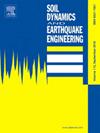Performance evaluation of revere fault-crossing buried pipeline with super-absorbent-polymer concrete as trench backfill
IF 4.2
2区 工程技术
Q1 ENGINEERING, GEOLOGICAL
引用次数: 0
Abstract
Geological and topographical challenges in fault zones pose significant risks to the structural integrity of buried pipelines. Previous studies have shown that continuously buried pipelines using loose sand as backfill material experience severe damage under active fault displacement. This study proposes the use of super-absorbent-polymer concrete (SAPC) as an alternative trench backfill to mitigate structural damage in buried pipelines subjected to reverse fault movement, as opposed to conventional backfill with loose sand. This study begins with the preparation of lightweight porous concrete containing large super-absorbent-polymer aggregates, followed by mechanical property testing to establish a constitutive model of SAPC. The SAPC is then employed to backfill the trench of a fault-crossing pipeline. A finite element model is developed to analyze the pipeline-SAPC trench-soil interaction and evaluate the performance of the pipeline when the trench is backfilled with SAPC. Critical parameters such as SAPC backfill length, overlying thickness, and elastic modulus are also examined for their effects on the performance of a buried pipeline. The numerical results indicate that compared with conventional backfill with loose sand, the critical reverse fault displacement of the pipeline can generally be increased by over 100 % after using SAPC as the backfill material. Optimal pipeline performance is observed when the SAPC backfill length is approximately 60 times the pipeline diameter. Besides, a thinner overlying SAPC thickness will generally enhance the performance of buried steel pipelines under reverse fault movement. Additionally, by adjusting the sand-cement ratio and SAP volume fraction, a SAPC with a higher elastic modulus can slightly improve the performance of the fault-crossing pipeline.
求助全文
约1分钟内获得全文
求助全文
来源期刊

Soil Dynamics and Earthquake Engineering
工程技术-地球科学综合
CiteScore
7.50
自引率
15.00%
发文量
446
审稿时长
8 months
期刊介绍:
The journal aims to encourage and enhance the role of mechanics and other disciplines as they relate to earthquake engineering by providing opportunities for the publication of the work of applied mathematicians, engineers and other applied scientists involved in solving problems closely related to the field of earthquake engineering and geotechnical earthquake engineering.
Emphasis is placed on new concepts and techniques, but case histories will also be published if they enhance the presentation and understanding of new technical concepts.
 求助内容:
求助内容: 应助结果提醒方式:
应助结果提醒方式:


